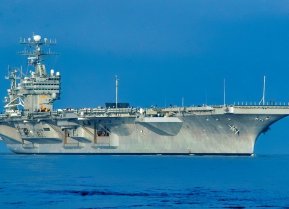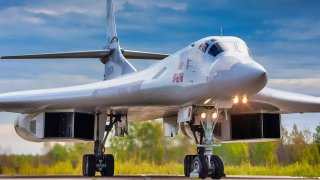Tu-160M: Russia Is Building A 'New' Supersonic Bomber
In July, the Kremlin announced that the upgraded Tupolev Tu-160M strategic bomber prototype had entered joint trials of the Russian Defense Ministry and the state-owned United Aircraft Corporation (UAC).
Russia is Building New Tu-160M White Swans - In July, the Kremlin announced that the upgraded Tupolev Tu-160M strategic bomber prototype had entered joint trials of the Russian Defense Ministry and the state-owned United Aircraft Corporation (UAC).
"The first upgraded prototype of the Tu-160M strategic missile-carrying bomber developed by the Tupolev Public Company (part of the UAC within Rostec) has entered the program of state joint trials," the UAC press office said in a statement.
The Tu-160M is being furnished with advanced armament and electronic warfare systems and onboard radio-electronic equipment based on state-of-the-art instrument-making technology. The first Tu-160M upgraded prototype was engineered under a large-scale program of modernizing operational long-range aircraft currently being implemented by the Tupolev Aircraft Company
Moscow had first unveiled plans to restart production of its Tupolev Tu-160 "White Swan" (NATO reporting name "Blackjack") – its Cold War-era supersonic variable-sweep wing heavy strategic bombers – in 2022.
Though these were the largest and heaviest Mach 2 aircraft ever to take to the skies, the Tu-160 was never produced in significant numbers. In fact, until last year, only nine test and 27 serially produced aircraft had been manufactured. That limited how the Russian Air Force could utilize the bombers as it lacked stealth capabilities.
A New Flock of White Swans Tu-160M Bombers
The first Tu-160M built under the resumed production completed its factory tests in December 2021, during which time the strategic bomber conducted maneuvers to check the aircraft's stability and control in the air, the working capacity of its airborne systems and engines, and the onboard radio-electronic equipment.
Russian President Vladimir Putin ordered the program restarted in 2015, but it took until last year for the first new serially produced bomber to be completed. Under the current plans announced last year, the Kremlin could receive upwards of 50 White Swans – yet, it still remains unclear how many could be produced annually.
UAC has announced that the Tu-160M will also reportedly be produced even as Russia continues to move forward with its PAK DA stealth bomber program.
It was in July that state media outlet Tass reported that the second newly-built Tu-160M strategic missile-carrying bomber had been sent to a flight testing station and the third aircraft was under construction.
What Do We Know?
The upgraded Tu-160Ms are also reported equipped with new onboard radio-electronic equipment, NK-32-02 engines, and other systems. The new aircraft are expected to serve as a key component of Russia's nuclear triad.
The White Swan was originally developed in response to the United States Air Force's Rockwell B-1 Lancer bomber – and the Soviet-developed aircraft has a similar design. As the world's heaviest bomber, it can carry nuclear-tipped cruise missiles that can destroy targets in remote geographic areas and deep in the rear of continental theaters of operations.
However, whereas the B-1 is a bomber in the classical sense – meaning it flies to targets to deploy its bomb load – the Tu-160 can operate as a stand-off weapons platform, where missiles are launched from bomb bay doors. After which, the White Swan could fly away at speeds of Mach 2+.
The variable-sweep wing supersonic strategic missile carrier was initially manufactured by the Tupolev Aircraft Research and Engineering complex joint stock company of Moscow and the Kazan-Gorbunov Aircraft Production Association in Tatarstan from 1980 to 1992. It took its maiden flight in December 1981.
The aircraft has all-weather, day-and-night capability and can operate at all geographical latitudes. High lift devices include slats, double-slotted flaps, spoilers, and flaperons used for roll control, while it is powered by four engines mounted in pairs in nacelles in the belly. It employs fly-by-wire controls and is equipped with three-strut landing gear, a tail wheel, and a brake parachute.
For take-off, the aircraft requires a concrete runway of 3,050 meters (1.89 miles).
Two compartments to accommodate the payload are located in tandem – one after the other. The airframe is made of titanium, heat-treated aluminum alloys, steel alloys, and composite materials. Tu-160 is reported to be equipped with a receptacle of the in-flight refueling system of a hose-cone type.
The White Swan was designed without any defensive weapons – its speed being crucial to evade enemy fighters. In patrol missions, the bomber is routinely escorted by fighter aircraft such as the MiG-31.
Truly Long Distances for Tu-160M Bomber
The aircraft has set a number of records during its service history.
In the fall of 2020, a pair of Tu-160 with two crews each broke the record for the longest non-stop flight for that type of aircraft. The two Tu-160 bombers, which were commanded by Major-General Oleg Pchela and Lieutenant Colonel Sergei Volkovitsky respectively, took off and landed at Engels Air Force Base outside of Saratov.
That base, which is the sole operating location for Tu-160 aircraft, is named after the Communist philosopher Friedrich Engels. During the 25-hour flight, the aircraft flew over the neutral waters of the central part of the Arctic and Pacific Oceans as well as the Kara, Laptev, East Siberia, Chukchi, and Barents Seas. Each aircraft was refueled mid-air three times from six IL-78 tankers.
Author Experience and Expertise
Peter Suciu is a Michigan-based writer. He has contributed to more than four dozen magazines, newspapers, and websites with over 3,200 published pieces over a twenty-year career in journalism. He regularly writes about military hardware, firearms history, cybersecurity, politics, and international affairs. Peter is also a Contributing Writer for Forbes and Clearance Jobs. You can follow him on Twitter: @PeterSuciu.
Image Credit: Image by Dmitry Terekhov.


